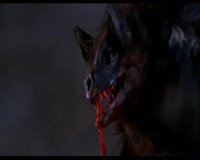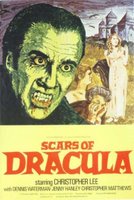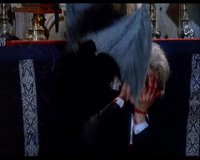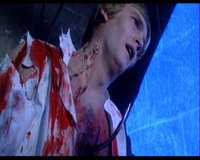 Director: Roy Ward Baker
Director: Roy Ward Baker
Release Date: 1970
Contains spoilers
Another outing for Christopher Lee as the Count and there are a few things to note about this film, firstly the continuity between this and the previous Taste the Blood of Dracula (1969) sucks. At the end of the previous film Dracula meets his demise in a chapel in England. Suddenly his remains, whilst set out exactly as they were in the previous film, are in his castle in Transylvania. There is no explanation and no logic to the move.
Secondly, the resurrection is awful. A bat flies in and drips blood from its mouth onto the remains. Again there is no explanation as to why it would do this. We are told during the movie that Dracula can control bats, but he is dead at the time.  The film also spells out, later, that vampire bats drink animal blood and human vampires drink human blood. How was the blood able to resurrect Dracula if it is animal blood? Okay, these bats do attack humans, when controlled by Dracula, but they naturally drink from animals. Is the clue in the previous film, when we get the throw away line about vampires drinking from both animal and human? If this is relevant, why is the point made in this that human vampires drink from humans?
The film also spells out, later, that vampire bats drink animal blood and human vampires drink human blood. How was the blood able to resurrect Dracula if it is animal blood? Okay, these bats do attack humans, when controlled by Dracula, but they naturally drink from animals. Is the clue in the previous film, when we get the throw away line about vampires drinking from both animal and human? If this is relevant, why is the point made in this that human vampires drink from humans?
Thirdly, this saw a marked shift in the cycle. Euro-horror had started to make its mark and, to compete with the more adult European offerings, this film contains high levels of gore (albeit with Hammer’s trademark bright red blood), compared to its predecessors, and is more overt in its sexuality – we even see a naked backside!
Lastly we have to mention bats. There are lots of bats in this movie and they are plot critical. There is no indication that the bats are vampires shape-shifted, again this power is ignored as it has been since the Brides of Dracula (1960), but we know they can be controlled by Dracula. Unfortunately Hammer never really got the hang of doing realistic looking bats and they do look awful.
Anyway, following his resurrection, Dracula slakes his thirst, off camera, on a village girl. We see her being carried back to the village. The villagers are incensed at this and decide to take care of the evil themselves. The village priest (Michael Gwynn), again a priest who is never actually named just like the priest in Dracula has Risen from the Grave (1968), tries to prevent it but they are determined. The women folk hide in the church as the men folk march to the castle with pitchforks and combustibles. The priest remains at a shrine on-route, to pray, and the villagers reach the castle and hide. The innkeeper (Michael Ripper) rings at the castle gate and a grate opens, he asks to be let in and states that he is alone. The gate is opened by Dracula’s servant, Klove (Patrick Troughton), and the villagers burst in, setting fire to the castle. Dracula is in his room, a doorless affair, with only an open window for entry and exit, and so is quite safe – or is he? As he is in an open casket we must assume the sun never faces that window! A bat flies in and hovers above the vampire. The villagers decide they have done enough damage and return to the village, collecting the priest on their way back. When they get back to the church, and open the door, bats fly out and the church is a scene of massacre. The bats have decimated the women folk.
It is a stunning opening, if you forget the implausible resurrection. A quick word here regarding Klove.  We first met Klove in Dracula, Prince of Darkness (1966). In that he was a creepy, yet austere butler (played by Philip Latham) who, if you recall, was shot and presumed killed. In this, played magnificently by Patrick Troughton, he is still creepy but also scruffy and hirsute, more servant than butler. Is it the same Klove radically restyled after his brush with death or do all of Dracula’s human servants have the same name? There is no answer, but Troughton makes the character his own and gives him great depth, whereas in the earlier film the character was little more than a cipher.
We first met Klove in Dracula, Prince of Darkness (1966). In that he was a creepy, yet austere butler (played by Philip Latham) who, if you recall, was shot and presumed killed. In this, played magnificently by Patrick Troughton, he is still creepy but also scruffy and hirsute, more servant than butler. Is it the same Klove radically restyled after his brush with death or do all of Dracula’s human servants have the same name? There is no answer, but Troughton makes the character his own and gives him great depth, whereas in the earlier film the character was little more than a cipher.
Miles away a birthday party is being thrown for Sarah (Jenny Hanley). Sat by her is Simon Carlson (Dennis Waterman); she asks him where his brother Paul (Christopher Matthews) is? He suggests he is working late. However Paul’s idea of working late is sleeping with Alice (Delia Lindsay), the Burgomaster’s daughter. He makes his excuses to leave Alice, saying he is going to night school, but drops the present he has for Sarah. Alice chases after him, believing he is going to another woman, wearing nothing but a bed sheet that fails to cover her rear. The Burgomaster (Bob Todd) returns and Alice claims Paul climbed through her bedroom window and tried to “interfere” with her. Paul escapes the Burgomaster but his footmen are sent after him, with the Burgomaster ranting about him being over-sexed (which he is) and cooling off in jail.
Simon has proposed to Sarah, in a rather bumbling manner, and she has not answered him. He assumes it is because of Paul who, at that moment, reaches the party. He gives Sarah his gift – a photograph of herself – but the glass of the frame has cracked. He says he will have it repaired when the footmen come into the room. Paul leaves by the window, landing in a coach, which startles the horses causing them to bolt. He climbs from the coach to try and control the horses, veering around a border gate to the sound of gunfire and, eventually, he is knocked from the coach which speeds away. It is a strange segment, with almost seaside postcard farce involved, but somehow it works. Paul is obviously a rogue, but we can’t help but like him – the cheeky scamp!
Paul reaches a village but everywhere is closed up. He knocks at the inn and a girl, Julie (Wendy Hamilton), sticks her head out of the window. She tells him that the inn is shut, the nearest village is 10 miles away and the only place nearby is the castle. When Paul asks her why the inn shuts after dark she can’t answer as she is new there. You can imagine the classified ad can’t you, “Village who lost all women in church massacre seek buxom wench to serve in local tavern, must be a hussy.” Anyway, Julie lets Paul in, but first she unbuttons her nightdress. After a rapid bit of flirting they are kissing and it looks like he has a bed for the night. Unfortunately the innkeeper comes in and kicks him out of the inn. It is a Hammer staple, the unfriendly innkeeper/villagers, but in this film we saw, with the massacre, a firm reason behind their frightened unpleasantness.
Paul trudges through the forest when he spies a coach with no driver.  He gets in and bunks down for the night. However the driver is Klove, who emerges from the forest with a deer over his shoulder and drives the sleeping Paul back to the castle. Paul awakens in the castle forecourt and leaves the coach. He has a nosey around during which he slips as a bat flies by him and twists his ankle slightly. A woman, Tania (Anouska Hempel), appears and invites him in. Once inside he meets Dracula, who has a lot more dialogue in this film. Paul begins to feel uneasy and, thinking with his head for once, suggests he will leave. Dracula insists he must stay, saying that this place is not Klienenburg. Paul is confused as to how Dracula knows where he is from and, quite frankly, so are we. It is never explained, or alluded to again, but has the Count now got the power to read minds in his arsenal of powers? Paul is taken to a room. It must be noted here that there is a brief allusion here to the fire, as there is later on, and it is hinted that very few rooms survived the inferno.
He gets in and bunks down for the night. However the driver is Klove, who emerges from the forest with a deer over his shoulder and drives the sleeping Paul back to the castle. Paul awakens in the castle forecourt and leaves the coach. He has a nosey around during which he slips as a bat flies by him and twists his ankle slightly. A woman, Tania (Anouska Hempel), appears and invites him in. Once inside he meets Dracula, who has a lot more dialogue in this film. Paul begins to feel uneasy and, thinking with his head for once, suggests he will leave. Dracula insists he must stay, saying that this place is not Klienenburg. Paul is confused as to how Dracula knows where he is from and, quite frankly, so are we. It is never explained, or alluded to again, but has the Count now got the power to read minds in his arsenal of powers? Paul is taken to a room. It must be noted here that there is a brief allusion here to the fire, as there is later on, and it is hinted that very few rooms survived the inferno.
Tania comes to Paul in the night and, in a scene straight out of Horror of Dracula (1958), asks him to help her as she is being kept prisoner. Unlike the earlier scene, however, in this one Tania and Paul kiss and then she demands that he love her, Hammer ramping up the raciness levels.  We cut to a post-coital scene and Paul is sleeping, Tania notices the pulse at his neck and vamps. Suddenly Dracula is in the room; he tosses Paul to one side and then viciously stabs Tania. Many have complained that the Count uses a weapon here, but it makes more sense then draining another vampire to death as happened in the previous movie. She is not entirely dead through the stabbing either. Perhaps Dracula may have done more, but the cock crows.
We cut to a post-coital scene and Paul is sleeping, Tania notices the pulse at his neck and vamps. Suddenly Dracula is in the room; he tosses Paul to one side and then viciously stabs Tania. Many have complained that the Count uses a weapon here, but it makes more sense then draining another vampire to death as happened in the previous movie. She is not entirely dead through the stabbing either. Perhaps Dracula may have done more, but the cock crows.
Paul awakens, covers Tania’s body and tries the door to find it locked. He makes a makeshift rope out of the bed curtains and climbs down from the window, it is a sheer precipice but luckily there is a window below. He enters, but unfortunately it is the Count's room with no door and someone is pulling his rope up. He looks into the coffin and sees the Count.
There is a padding scene next, with the police looking for Paul in the village and Julie mentioning the castle and then we see Klove enter the bedroom of the castle with a bath of acid and tools with which to cut up Tania (which is why I said she was not entirely dead – Klove is obviously making sure). He finds the picture of Sarah and is most taken with it.
Simon and Sarah are looking for Paul and reach the village. Paul questions the innkeeper and gets thrown out of the inn for his trouble, but Julie (once again) tells the couple that he went to the castle and how to get there. On route they seem to get engaged. It is dark when they arrive and a bat swoops at them outside the castle door. They enter the castle, to escape the bat, and meet Dracula. Sarah swoons slightly and Dracula offers them a bed for the night, Sarah in the room that Paul used (to which she is carried by the Count) and Simon in the drawing room on the couch. During conversation the Count denies that Paul was ever there. Before he retires Simon is given a drink by the Count and later, when he tries to rouse himself and fails, it is intimated that the drink was drugged.
In the night Dracula goes to Sarah. He is about to have his toothsome way with her but is deterred by the cross she wears. He rings for Klove to remove it, and whilst I agree that this is rather a poor display on behalf of the Prince of Darkness, it is plot important. Up to now Klove has not seen Sarah, when he does he recognises her as the girl from the picture and refuses to remove the cross.
In the morning Simon goes to see Sarah, they have both overslept. Whilst Simon is with her a tray of broth is left outside the door. He lets her eat as he looks for Klove and, in Klove’s room, finds the picture of Sarah. He fights Klove and discovers bloody marks across the servant’s back (his punishment for disobedience). Klove suggests that Paul escaped, says that he will help them escape also and then realises that Sarah has the broth. I assume here that the broth is drugged to keep her at the castle. Simon smashes the bowl and Sarah has only taken a small sip, they leave and head back to the village. They get short shrift from the innkeeper but the priest approaches them, telling them he will help. That help includes a brief lesson around the subject of vampires, a rosary for Simon and a promise to go to the castle with him in the morning. There is an interesting line about Dracula being both a monster and a vampire, are not all vampires monsters then?
 Julie, in the meantime, is unhappy with her lot in the village and leaves. The innkeeper tries to stop her but she will have none of it. We cut to Klove being punished by Dracula, a red hot sword being pushed against his skin. Klove is sent into the night and kidnaps Julie, the girl becoming a midnight snack for the Count.
Julie, in the meantime, is unhappy with her lot in the village and leaves. The innkeeper tries to stop her but she will have none of it. We cut to Klove being punished by Dracula, a red hot sword being pushed against his skin. Klove is sent into the night and kidnaps Julie, the girl becoming a midnight snack for the Count.
Simon and the priest leave Sarah at the church and head for the castle, the priest’s courage fails, however, and he goes back to protect Sarah. Simon gets into the castle by telling Klove Sarah is with him (will the man never learn, that’s the second unwelcome guest allowed in with a variant of the same trick). He forces Klove to show him how his brother escaped and is shown the window. Simon climbs down, makeshift stake in belt, having returned Sarah’s picture to Klove and locked him out of the room. Klove gets back in and cuts the rope but Simon manages to get into the window, though he looses his rosary. He goes to stake the Count, whose eyes flash red through his eyelids, and the would-be vampire slayer collapses.
Back at the church Sarah is awakened as a bat flies in. She runs off into the forest as the bat kills the priest. Simon wakes and finds Dracula up and about. The Count demands to know where she is and Simon claims she is safe, but a bat flies in and the Count mockingly states “I think not.” He climbs out of the window and up the wall as Sarah enters the castle, at the same time Simon finds Paul, and the find is gory,
is awakened as a bat flies in. She runs off into the forest as the bat kills the priest. Simon wakes and finds Dracula up and about. The Count demands to know where she is and Simon claims she is safe, but a bat flies in and the Count mockingly states “I think not.” He climbs out of the window and up the wall as Sarah enters the castle, at the same time Simon finds Paul, and the find is gory,  Paul is impaled on the wall and very dead. Dracula hypnotises Sarah but Klove shouts about the cross and the spell is broken as she wards him off and runs out. Klove drops a rope to Simon as Sarah is confronted outside, she holds the cross again but a bat swoops and steals it and those hypnotic eyes work their magic. Klove attacks Dracula but is thrown over the edge of the precipice. Then Simon appears and throws a metal stake like a javelin, hitting the Count’s stomach. The vampire pulls it out and is about to throw it at Paul when lightening strikes it and he bursts into flames. It is an unexpected ending, and a great one, the earlier fire finally claiming him in a most unusual manner.
Paul is impaled on the wall and very dead. Dracula hypnotises Sarah but Klove shouts about the cross and the spell is broken as she wards him off and runs out. Klove drops a rope to Simon as Sarah is confronted outside, she holds the cross again but a bat swoops and steals it and those hypnotic eyes work their magic. Klove attacks Dracula but is thrown over the edge of the precipice. Then Simon appears and throws a metal stake like a javelin, hitting the Count’s stomach. The vampire pulls it out and is about to throw it at Paul when lightening strikes it and he bursts into flames. It is an unexpected ending, and a great one, the earlier fire finally claiming him in a most unusual manner.
Many claim this to be a weak film in the cycle. Okay the plot is hackneyed; couple go to castle yadda yadda yadda… plus the resurrection is awful, but the film as a whole is great fun, doing everything that a Hammer film should do. The Count’s dialogue is back on form, with the Count receiving a much larger amount of screen time than in some of the previous films, and I love the concept of Klove betraying his master for love and the pain he feels as he betrays Dracula and yet still wants to please him is beautifully portrayed. Add the high gore (for a film of its time) and you have a worthy film in the cycle - 7 out of 10.
For the imdb page go here.
Thursday, June 01, 2006
Scars of Dracula - review
Subscribe to:
Post Comments (Atom)















8 comments:
I used to hate this film, but it grew on me as time went by. As you've noted, the Dracula resurrection scene at the beginning is embarrassingly bad. And, as you further mention, Hammer seems to have a horrible time constructing a believable bat. Maybe it is harder than it looks.
As the film progresses, though, I become more forgiving and get wrapped up in the story.
This is definitely not one of my favorite films of the cycle, but it far surpasses what's coming up next.
I'm anxious to read your review of Dracula A.D. 1972!
Mark the Dracula AD 72 review should be up this evening (UK time).
Many thanks :)
with "Scars of Dracula" Hammer and Baker tried to re-animate the serie.
This wasn't a sequel to "Taste the blood of Dracula" just a New Start.
So there's no problem with continuty or about the charachter of Klove,that can be alive as well.
I dislike number ratings but in my opinion the movie isn't good. We have the gore (often non-sense, like the dead of the priest) but we have no atmosphere. the plot is poor and the end cheap. Klove as well doesn't work.
enrico, I respect your opinion. As eismann commented, many consider it a stinker - I don't know why it strikes a chord with me, but it does.
I did like Klove but do take your point regarding a reimagining, but they did have everything set out as it was at the end of taste the blood.
Many thanks for taking time to read and comment
no. thanks to you for your work.
I mentioned Scars of Dracula in this Blogspost of mine
http://solascripturachristianliberty.blogspot.com/2015/06/hospitality-is-important-biblical-value.html
cheers Jared - Prince of Darkness also has a strong theme of hospitality -albeit used for nefarious ends
Post a Comment